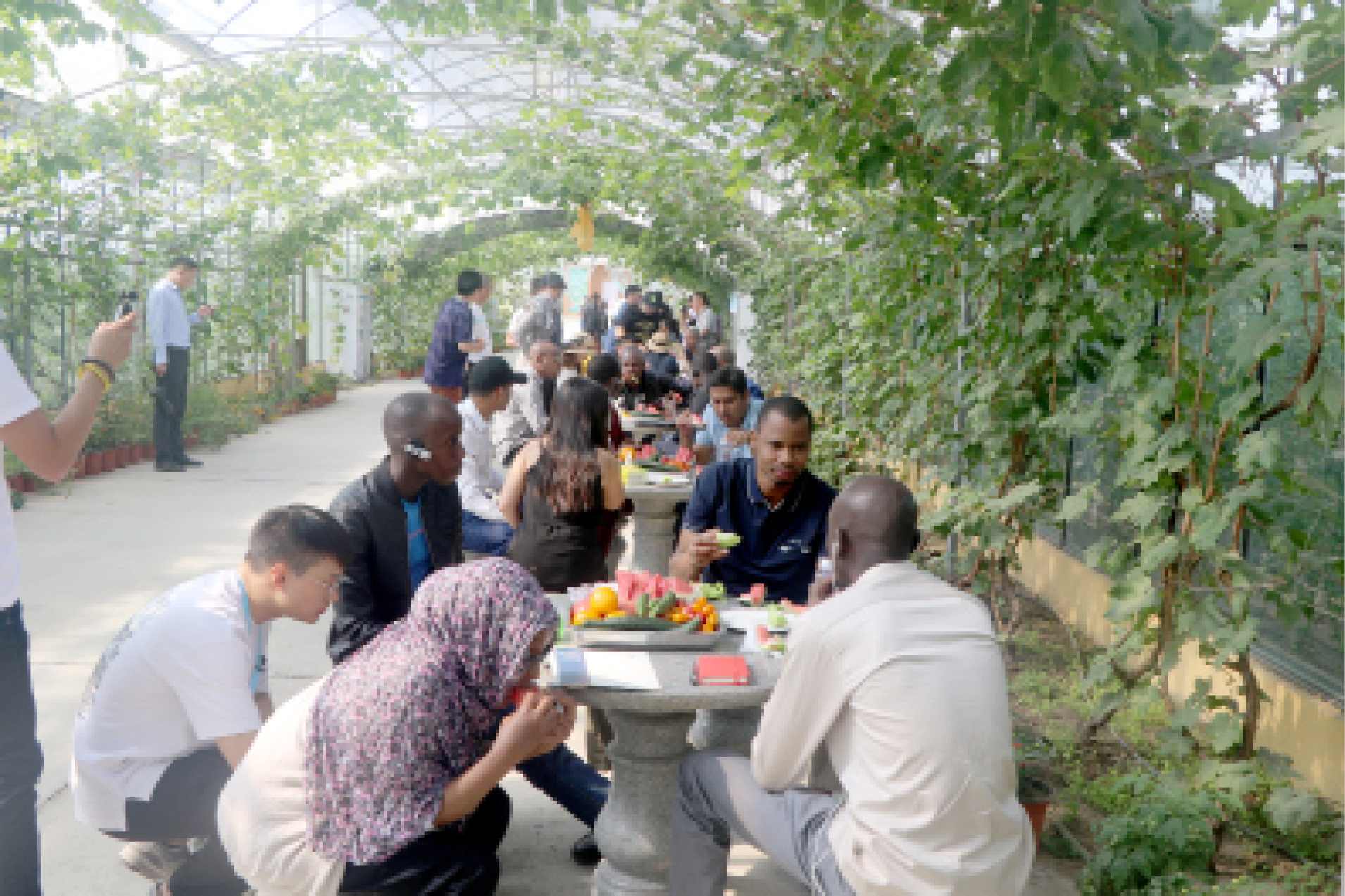The peaks of Kubuqi desert shimmered on a sunny afternoon above a bleak valley spread out under the azure sky. The towering dunes, overlooking a flat, sandy plateau, had been verdantly landscaped. Far in the distance, an oasis stretched for metres. In this stunning scenery, created jointly by nature and manpower, we braved the scorching sun to watch the greening of the barren land.
We had come for an afternoon visit to Kubuqi desert during a recent trip to Inner Mongolia, an autonomous region of northern China. The ostensible purpose of the trip was to witness how the government is fighting desertification.
Inner Mongolia covers a total area of 1.18 million square kilometers or 12.3 per cent of China’s total land area, and has a population of 25.2 million, made up of 55 ethnic groups, such as Mongol, Han, and Manchu, of which the 4.43 million Mongols accounts for 17.1 per cent of the total population in the region.
Inner Mongolia is one of the provincial-level regions in China most severely affected by desertification, with half of its land covered by deserts. It is home to four of the eight largest deserts, respectively the Tengger, the Badain Jaran, the Ulanbuh, and the Kubuqi Deserts, and the four biggest sandy lands in China, respectively the Hunshandak, the Horqin, the Mu Us, and the Hulun Buir Sandlands.
The two-hour bus ride to Kubuqi from the airport was as scenic as the desert itself. Here were innocent stretches of earth that had been neither exploited nor deliberately preserved. Far in the hot dunes, the sun made imaginary water, shimmering impossibly far away as we drove along a little-travelled but well-maintained road splitting the horizon. The desert starts gradually: bit by bit the plants become sparse, and then the land flattens.
China is at the forefront of the world’s efforts to combat desertification and is the first country to achieve the historic transformation from “sand advances and people retreat” to people advance and sand retreats.” For three decades, the Asian nation has committed US$4.35billion and US$430million in industrial and public welfare desertification control respectively.
The Kubuqi desert, the seventh largest in China with an area of 18,600km, is located in the Hangjin Banner of Ordos on the southern bank of the Yellow River, the sixth longest river system in the world at the estimated length of 5,464 km.
Thirty years ago, the Kubuqi desert was referred to as a “Sea of Death,” with a vegetation cover of less than 3 per cent and dunes up to a height of over 100 meters.
The area was home to some of the highest concentrations of impoverished populations.
Meteorological data showed that Kubuqi desert has a temperate continental arid monsoon climate, with long winters, short and warm summers, windy springs and cool autumns.
It is 800 kilometres west of Beijing, China’s capital. With the help of a severe gale, the sand from Kubuqi could be blown through to Beijing overnight, thus called “a basin of sand hung above the capital.”

In his Desert Control Philosophy, Wang Wenbiao wrote: “The 740,000 people living here had suffered from sand hazards for generations. Farmers and herders lived at the mercy of nature and constantly moved around the desert. The Kubuqi became a synonym for ‘desert’ and ‘poverty’ in China. There was no water, no electricity, no roads, and no infrastructure. Farmers and herders in the desert lived a hard nomadic life by relying on a few sand plants. The poor here were the poorest of the poor, and poverty alleviation in these areas was the hardest of all to accomplish.”
As the journey advanced, my gaze drifted toward the window. I observed that the greening of the vast desert is fast progressing. After three decades of sustained efforts, Kubuqi has seen 6,000 square kilometres of its land being afforested; special plants have been grown to grip the shifting sands and to prevent the dunes encroaching on farms and villages.
“The area of moving sand has decreased from 73.3 per cent to 44.5 per cent of 1.5 million acres, the total area of ecological control. The proportion of fixed and semi-fixed sandy lands increased from 26.7 per cent to 55.5 per cent. Vegetation coverage and biological diversity have also significantly increased, while regional bouts of sandy and dusty weather have noticeably decreased,” according to a report by China’s Society of Sand Control and Sand Industry.
The desert is being controlled by planting arbours, shrubs and grass, using a series of techniques, including minimally invasive planting, wind-data-based planting, and aerial seeding and drone planting. Two of the techniques were demonstrated before us: a high-pressure water jet dug and watered a hole, and then willows were planted. The auger planting technique, also named “Dry Planting,” uses an auger driven by micropower to create holes, in which seedlings are planted and sand rammed. These techniques reduce planting time from 10 minutes to 10 seconds per seedling. “It only takes few minutes to plant dozens of trees,” said Zhao Xingwang, an official of Elion, a desert control firm.
In the heartland of the Kubuqi desert, where 30 years ago was barren and lifeless, rich greenery of desert poplars abounds. Standing upright in the depths of the desert, poplars safeguard oases against desertification, together with all those dedicated to afforestation in the desert. Firmly grounded here, these tenacious and resilient plants sink their thick roots through shifting sand deep into the ground in a search of soil they can grow in.

After that, they sprout and thrive, showcasing their beauty and grace, even in the worst climate conditions, and eventually growing into a green Great Wall against sandstorms in Kubuqi.
Of the 10,000 desert poplar trees introduced to Kubuqi in 2003 from the Badain Jaran Desert in Inner Mongolia, only 20 per cent or 2,000 survived. But after more than a decade of dedicated cultivation practices, the number of the poplar trees in Kubuqi has grown from 2,000 to 50,000.
Desert poplars boast of enormous vitality, signifying harmony, longevity and good fortune. They are remarkably tolerant of drought, salinity and changeful climate in a harsh desert environment. With strong capabilities of growth, each poplar once planted will develop into a grove consisting of 10 to 15 trees in ten years. This means that one desert poplar can green a desert area of 30 square meters, highly beneficial to ecosystem conservation.
Now, the ecological resources of the desert have enjoyed gradual increase, the region’s ecology has witnessed an obvious improvement, and the economy of the sandy areas now boasts steady development. Sand control has provided the local people with jobs and benefitted thousands of farmers and herders.
China is one of the world’s biggest carbon emitters, but is also determined to rebalance its energy mix and incorporate more clean energy. It hosts a majority of the world’s top solar manufacturing firms, while the cost of panels has also dropped. In 2017, nearly half of the world’s new renewable energy investment of $279.8 billion came from China.
“No country has put itself in a better position to become the world’s renewable energy superpower than China,” said a January 2019 report, which was issued by the Global Commission on the Geopolitics of Energy Transformation, a group chaired by a former president of Iceland, Olafur Grimsson.
The government exploits Kubuqi’s abundant sunlight to develop and execute an eco-solar energy project.
In the evening twilight before the glow of sunset retreated from the skies, we crested a flat plateau at China’s largest single-stage solar farm and saw hundreds of thousands of fixed and sun-tracking panels spread out before us.

The project, with a gross planned investment of RMB 11 billion, channels 1,000 megawatts of electricity into the national grid and restores around 6,700 hectares of deserts at the same time. Underneath the solar panels served as a ground for crops and livestock farming. The panels control sunlight and wind, making the plants grow better.
Thrilled by the greening of the vast desert, and of the plush glamping experience at the Seven Star Lake Resort, there were still cultural experiences to be had. We paid a visit to the family of Mengke Dalai, who lives in a 106-square-meter house in a new village built for herdsmen in 2006. There, we were treated to a slap-up meal and had a brief chat on his life and occupation.
Dalai’s family was one of the 36 households of herdsmen who, before 2006, had lived scattered in the desert stretching over 1,000 square kilometres. As the ecology deteriorated, herdsmen found it increasingly harder to live a nomadic life while their income sharply shrank.
Now each household lives in a decent house, and has livestock and planting sheds. For one thing, they are enabled to practise concentrated plantation and animal husbandry; for another, they are offered more guidance about how to engage in local desertification control while developing tourism and farm stay business.
Taking horses and camels as exotic tourist attractions, these 36 households of herdsmen have all lifted themselves from poverty and now live a moderately prosperous life, with the highest annual income reaching hundreds of thousands of Yuan. On top of that, the 1,000 square kilometres of desert they used to herd their livestock has turned into life-giving oases, thanks to the change of lifestyle.
In northern Nigeria, desertification is increasingly rendering large swathes of fertile land into desert. The West African nation loses approximately 350,999 hectares of land to drought and desertification annually, the Nigerian Meteorological Agency (NiMet) said in March. The effects had been felt across the country. Growing desertification and drought had destroyed millions of livelihoods, especially of farmers and herders, whose struggle for resources had resulted in bloody clashes.
The Nigerian government’s many initiatives, including the 2012 Presidential Initiative on Afforestation, had suffered setbacks due to long list of problems, including inadequate funding, inconsistent government policies, lack of monitoring and corruption.

The Kubuqi model represents one of China’s ground-breaking achievements in improving the ecological environment. Though the model cannot be emulated in its entirety, it can inspire other countries, including Nigeria, to devote more energy to desertification control.
An evening walk in the sleepy Hanggin in southwest Inner Mongolia, where barren desert had given way to tree-lined avenues, offered an insight into the level of Kubuqi’s achievements in covering desert with greenery. After 30 years of hard work, Kubuqi has transformed thousands of kilometres of barren desert to a green land. The neighbourhood is crisscrossed with a network of wide, asphalted roads, with streetlights lining both sides.
The night before we left Kubuqi, I stood by the window of my hotel room, just as the sky hung low and dime above the city, relishing its splendour. The moonlight shone on rooftops, shielding silver streaks across the sleepy neighbourhood. The wedge of the moonlight penetrating through a latticed window left half of my room dimly lit. That moment, what propped up in my mind was the doggedness of the government in combating desertification. Their efforts deserve to be recognised beyond the borders of Inner Mongolia.

 Join Daily Trust WhatsApp Community For Quick Access To News and Happenings Around You.
Join Daily Trust WhatsApp Community For Quick Access To News and Happenings Around You.


